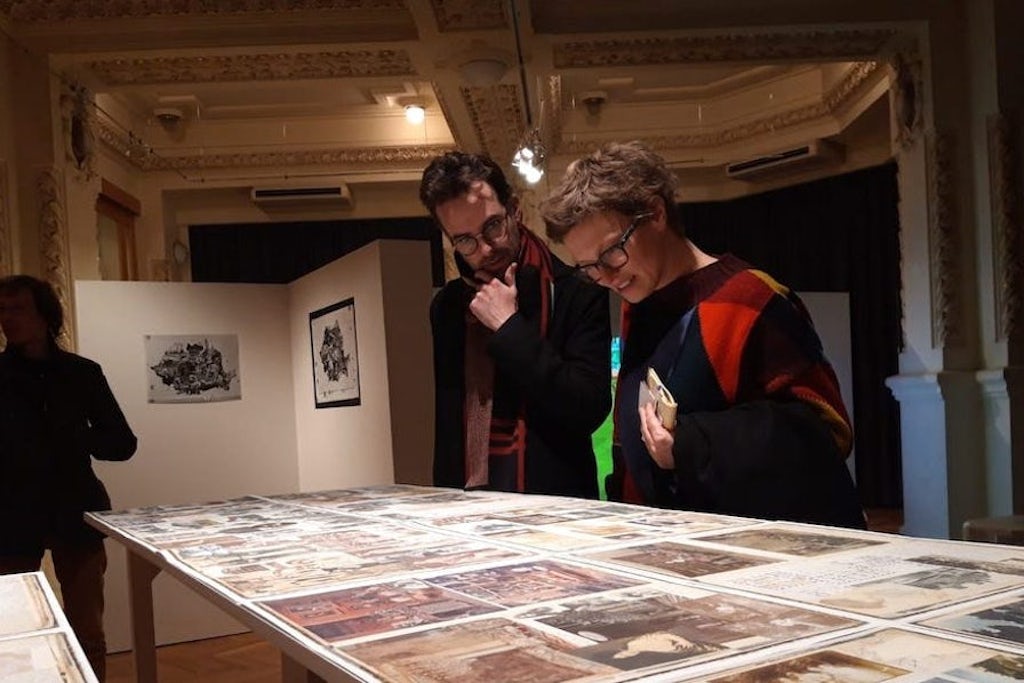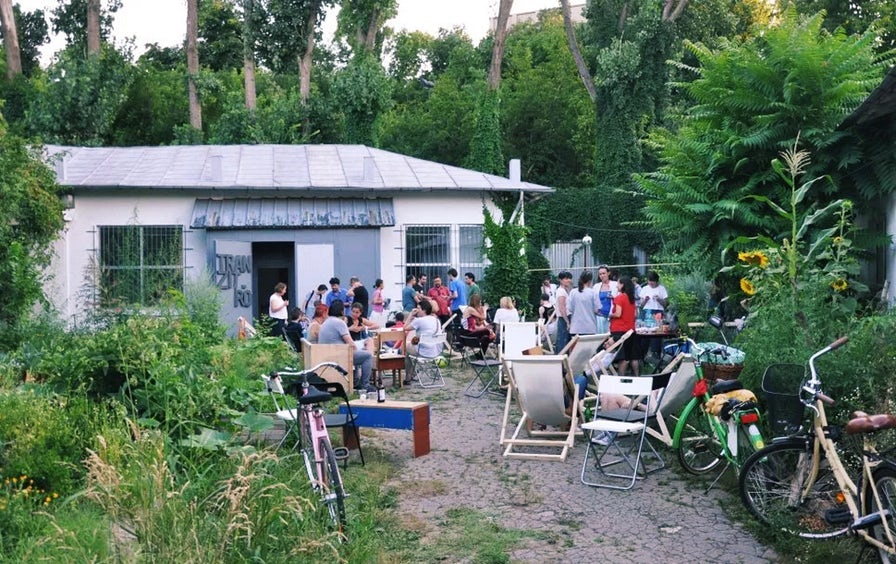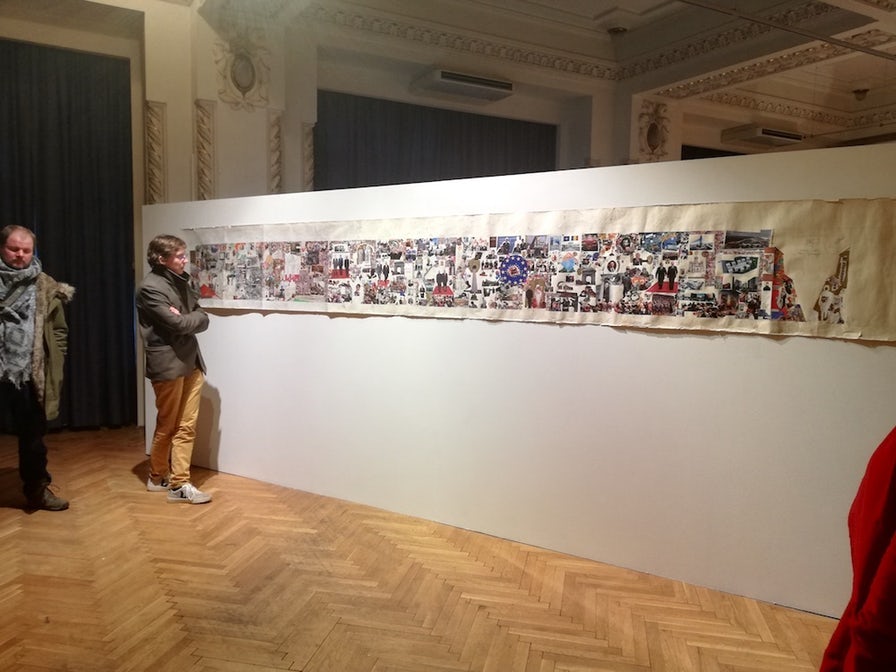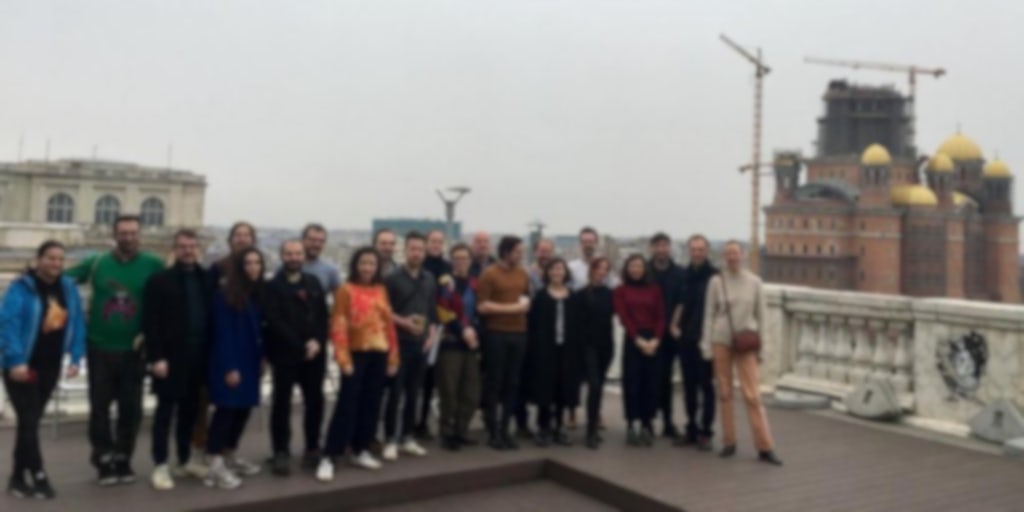
Together, once again. Looking back on a working visit to Bucharest.

Tom Bonte en Danielle van Zuijlen tijdens het werkbezoek aan Boekarest (c) Dragos & Erika Olea
Twelve art professionals from Flanders – active in visual arts, performance art and sound art – joined Flanders Arts Institute on a working visit to Bucharest, a city with a very dynamic art scene, consisting of important institutions as well as emerging initiatives by artists. The architecture and city-planning are determinant and inspire artistic interventions. Danielle van Zuijlen and Stijn Demeulenaere reflect on their impressions.
Scroll down to the bottom of this page for an overview of all visited locations and people, and a list of participants.
A pinnacle of contradictions
Bucharest is a city where ‘every group clashes with the other’. This is how architect Stefan Ghenciulescu started his crash course lecture on Romania and the city of Bucharest, and it proved to be a recurring theme in the three day visit to the city’s contemporary art scene, organised by Flanders Arts Institute.
I was one of the lucky people to join a group of Belgian curators and artists that was guided through the city by Dragos and Erika Olea (from art collective Apparatus 22). Now based between Brussels and Bucharest, by the invitation of Flandes Arts Institute the artists carefully put together a packed programme through the city, focusing on visual art, art in public space, music/sound art, the hybrid field between performance, dance and visual art and new institutional models as a critical response to precarity and neoliberal culture.
Dragos and Erika introduced Bucharest to us as ‘a pinnacle of contradictions’ between the official cultural discourse and the ‘more sparkling side of the cultural landscape’. Their selection of spaces and artists provided us with an insight in the complex relations between independent mini-institutions, commercial galleries, museums and larger institutions, against the background of a country that is plagued by corruption, nationalism and top-down (identity) politics with little interest in citizenship and democratic debate. For half a day, the group split up for a music or visual arts route, but the larger part of the trip we formed one Belgian body roaming through Bucharest under the energetic guidance of Dragos and Erika.
We start with the situation that is Bucharest. Three remarkable sites of monumental scale are telling for the city, two of which are neighbouring each other. The first one is the famously colossal Palace of the Parliament, in which also the Museum for Contemporary Art is housed (that, despite its respectable scale and 4 floors of art, is only taking up 4 % of the entire Palace). Right next to it stands the newly built, National Cathedral of Redemption, a megalomanic orthodox cathedral, that should contribute to the national identity (80% of the population is Romanian-orthodox.) The new monument is rivalling the palace in architectural dominance. It takes 40 minutes to walk around the site where both giants stand next to each other, representing the state and religious powers that dominate the city. Our hotel provided us with a postcard view on both.

The third site of note is a hidden, vast terrain on the south side of the city, surrounded by a concrete wall that was constructed in communist times to turn the site into a water reservoir. As the regime fell, the walled site was never finished and forgotten, turning itself into a wet landscape in which a new eco-system of animals and plants emerged. Its rediscovery by photographers also brought the danger of it becoming an exploited tourist site and a site of speculation. After many years of civil actions, in 2018 the site was officially protected and named Văcărești Nature Park. Its protection as a nature park is seen as one of the few successes of civil society in the last years – it is the kind of protection the cultural field can only dream of.
In between these large sites of self-generated nature and monumental architectural structures of power display sits the widespread city of Bucharest. It has the typical atmosphere of any Balkan city, with at least twenty communities in each area. Ottoman, Austro-Hungarian, modern, communist and capitalist times are reflected in its architecture as these different historic periods try to cohabitate with each other, being visible in every street. The period of modernization between 1850 and 1940 was not an extension of the city, but a superimposition: new layers grew over the old city. All this changed a lot during the totalitarian communist regime, when construction was coordinated by the state, who put ‘everybody together’ in concrete building blocks. Ceaușescu, wanting to build a new city, destroyed a lot – if only for the construction of his palace. But after the end of communism in 1989, the ‘everybody together’ turned into an ultra-liberal ‘everyone for themselves’, the city becoming a collision of individual dreams and ‘an archipelago of closed private islands’.
Restoring communities and public space
This capitalist mood currently invokes the response of projects that once again accommodate the commons and shared space. As StudioBASAR explained in their presentation, a lot of common practices survived into present times and are now being reinvented. They explain how neoliberal Bucharest, in the hands of real estate companies and dependant on political decisions concerning development of sites, is a very conflictual space, with a clear need for communal safe zones. The answer of StudioBASAR is the construction of mobile pavilions that create public space and re-initiate community activities, acting as a safe intermediary space between different organisations and locals. As such, artistic interventions help to generate a spirit of ‘together, once again’. Also the well-done reconstruction of the house of the Bucharest Order of the Architects (OAR Bucuresti), by whom we were hosted on the first day of our trip, is a successful example of how public space can be created anew as part of a restoration project. In the new version the site generates space to be used by the neighbouring school and the surrounding community.
StudioBASAR’s answer to the predominance of real estate companies and political decisions concerning development of sites is the construction of mobile pavilions that create public space and re-initiate community activities, acting as a safe intermediary space between different organisations and locals.
A different answer to the neoliberal lack of public space is tested by Template, a collaborative project by several artists from Bucharest who invite international colleagues to realise temporary artistic interventions in specific disused buildings they spot in the city. They activate these spaces – mostly kiosks – from a shared interest to show an alternative use for spaces that would normally only house shops. To be able to rent the spaces temporarily, they’re dealing with a lot of bureaucracy and not all owners of spotted sites are willing to collaborate. ‘Template’ also grew from a need to contribute to a more diverse artistic scene by bringing young international artists to Bucharest.
To enter the new building of the independent mini-institution ODD, ‘a space for theoretical discussion and social gatherings of all kinds’ founded in 2014, we make our way through a gate, to a house behind a house. The new ODD is still finding its feet as a collective – since 2019 it is run by a team of 9 artists and curators, who are currently redefining the programme. Taking its name from a described mental disorder for oppositional personalities, ODD is clearly positioning itself as a critical voice. At the same time, they state that they oppose ‘the normativity of liberal critical art’, not wanting struggle of life to be the defining motor. Instead of lingering in negativity, they’re building a communitarian practice. They also want to escape the ‘alternative art space narrative’, and rather see themselves as a ‘pointer’ to the community instead of a space, better prepared to navigate difficulties as a collective force. With each member of the collective contributing with their own project, the exact meaning of their collectivity is still to be developed.
Most of the curators presenting an institution have returned from studying or working abroad. This also goes for the curators of Suprainfinit Gallery, who came back to Bucharest to represent emerging Romanian artists. The show on view is atypical, with works of Andrei Chintilă, an underrepresented Romanian figurative painter who died in 2010, and lived in Belgium in the nineties.
The name of the gallery was devised by our hosts Apparatus 22 – giving names to spaces is part of their practice. So Suprainfinit Gallery is the logical place for a talk on the work of Apparatus themselves. Ranging from names, installations and happenings to painting, care for the ecosystem of art is also a strongly recurring element. One of the works they present, ‘Art is Work’, is an overall to be worn by artists during the opening of a show, with the intention to open up discussions on artist fees. Art is Work is based on a utopian piece of clothing from the late 20s, brought back into production by Apparatus 22. The beautiful garment (Apparatus originally started off as a fashion label) displays either the message that the artist was paid for the artistic work, or was not paid and accepted that as the agreed deal.
Anca Poterasu Gallery is the other commercial gallery we visit. Curator Cristina Stoenescu introduces the space in its small entrance, giving it the feel of a smaller project space. But upstairs there is a larger second space, where Olivia Mihaltianu presents her video art practice. And an inner garden leads us to the quarters of their ‘international artist in residence’ that is running since 2014. In a ‘Letter to our friends’, a text that accompanies a group exhibition of Romanian painters, the gallery announces the opening of a satellite space in Leipzig and having participated in four international art fairs in 2018.
The developing scene of sound art and experimental music
Stijn Demeulenaere reports on half a day of sound art. He explains how artists come to sound art from many different backgrounds, which turns out to be no different in Bucharest. Take Sillyconductor, an artist who just as easily makes an installation as he creates music, and the social artistic work of Paul Breazu, who organizes festivals to build communities.
Sambata Sonora (Sounding Saturdays) is the only sound institution in the programme, and possibly the only one working around sound art in Bucharest. Co-founder Anamaria Pravicencu explains that the scene is young and very small. Coming back from working abroad they found there was no place for sound art or experimental music, so they started doing it themselves.
Founded in 2009, Sambata Sonora is a platform for adventurous sound and experiments in listening. Their activities include a festival, the podcast and radio art platform Semi Silent, and a series of workshops, “Her voice”, designed to support female artists. Their new residency program, “Sonic Futures” focuses on the relationship between sound and the land. It’s aimed specifically at working outside of Bucharest and offers residencies with a scholarship to individual Romanian artists – apparently a rarity in Romania for sound art – as well as a collective residency with a well known name from sound art or field recording. The artist Simina Oprescu is one of the products of Sambata Sonora’s efforts. As a video artist captured by the imaginative power of sound, she did several of Sambata Sonora’s workshops and then studied abroad. At the first Semi Silent Awards she won this year’s audience award for her work “Drip Drop”.
‘The contagious hug of radical ideas’
In the afternoon of the second day, the group is united again for a visit to the National Dance Centre. Initiated in 2004 and after being nomadic for 2 years, the institution is active in its current space since 2013. Originally conceived as a space for dance theatre, it operates in the hybrid field between dance, theatre and visual art. The institute’s energetic director Vava Stefanescu shows us the plans for reconstruction of the nearby old Senat Building, which will turn them into a major institution. Architectural plans are finalised and reconstruction should be ready by 2021. The question arises whether such an elaboration in scale leaves enough budgets for programming. There is no clear answer to this yet. The independent artist in Romania has no official statute, underlining the precarious conditions in which this scene operates.
The hybridity of the field this institute represents is clear from the artist’s presentations. Mihai Mihalcea, the institutes’ founding director, talks about his artistic alter ego that is embodying the artist Farid Fairuz. This fictional persona creates critical performances on capitalism, sexuality, cultural production and religion that mirror failures of the society.
Choreographer and filmmaker Simona Deaconescu (Tangaj collective), creates dance performances that take inspiration from scientific theories like ‘non-locality in quantum-physics’ and futurist philosophies. She shows us a work with 15 dancers that was staged in the National Museum. Physical queer activist Paul Dunca talks about his hybrid practice of pop music and performance. Coincidentally, some of us get to witness him in action a few days later in nightclub Apollo111, where he turns out to be the DJ at a LGTBQ party.
As a way to consider new directions for the future, several people serve us ‘A Wish for Bucharest’ at Tranzit.ro, alongside a gorgeous homemade meal by Apparatus 22. KILOBASE BUCHAREST wishes all the people of Bucharest ‘to receive the contagious hug of radical ideas’, accompanied by the suggestion for a squad of designers taking over Bucharest city hall, radically tackling all the design needs of the city. Not in ‘Dutch design’ style – that would feel alien to the people, but on the basis of extraverted Bucharest Kitsch. This love for Bucharest Flamboyant Kitsch is reflected in the choice of several of the restaurants where we eat the following evenings, most notably the Cercul Militar National.

With her wish for Bucharest, Iuliana Dumitru from Tranzit.ro describes Bucharest as an ill body whose organs should work better together. It is an image I recognise from Ghent, where we have formulated the wish for the arts field to see itself as a team of complementary players. In Bucharest, the (financial) distance between the museum and the rest of the organisations in the field is even more immense than in our surroundings. There simply is no middle field between museums and small independent spaces. Read the text by Iuliana.
With its programme, the more institutional Tranzit.ro attempts to take on that role. The institution is part of an Eastern European network of Tranzit spaces, funded by the Erste Foundation, an Austrian bank that supports liberal, democratic values and European cohesion. Nevertheless, the institution remains fragile. It’s a recurring worry that ‘this could be the last year’. Meanwhile, with a history of seven years on the same site, they are a relatively stable organisation in Bucharest terms, regularly producing critical international exhibitions while using their garden as a community space. Neighbours gather here to cultivate flowers and plants in an ecological and sustainable way, which is a metaphor for finding new ways of living together, caring about surroundings and cultivating fair social relations as a remedy against individualism and inequality. Tranzit.ro also hosts projects of like-minded initiatives and their staff contributes as editors to art magazines. Projects like the annual ‘The end of the world festival’ suggest that doom and threat are never far away. In these circumstances, a lot of hope is on European funding. Even if requirements are quite specific, ‘you can always squeeze in our own programme’.
The (financial) distance between the museum and the rest of the organisations in the field is even more immense than in our surroundings. There simply is no middle field between museums and small independent spaces.
Tranzit.ro does not formally collaborate with the National Museum of Contemporary Art. They are critical of the museum as institution (‘while the museum has great researchers, they’re not given the curatorial power to disseminate their ideas’) but extremely positive on the collection and its treasures from the socialist past. During our days in Bucharest, repeatedly references are made to the special collection of the museum, especially from the social realist period. The collection of the National Museum, housed in the Palace of the Parliament, encompasses 6.000 pieces. Curator Sandra Demetrescu confesses that in the past, quite a few of these pieces travelled to consulates and cultural centres across the world – and never came back. The process to recuperate the work is slow and complex.
When asked on Tranzit.ro’s role in local collaboration, they explain that with recent widespread protests against corruption, everyone joined together on the streets of Bucharest, generating the feeling that ‘we all have the same needs’. Since then, the field is coming together in a constructive way and working towards an association of independent organisations. Potential is everywhere.
The Future Museum, housed inside the Czech cultural centre in Bucharest, recognises the need for a middle-sized gallery that provides production budgets to artists. Its programme responds to this local need and therefore only focuses on larger solo shows by Romanian artists, and supporting their mobility within Romania. We see a solo exhibition by Alexandra Croitoru, who will curate an exhibition in CC Strombeek near Brussels later in 2019 as part of Europalia Romania (which of course also provides the context for our trip to Bucharest.) Croitoru’s work stems from photography and revolves around extremely subjective historical reconstructions, based on subjective photographic archives and collage of images. The large ‘Fresco for Romania’ is a collage made of cuttings that was created ten years ago, following suggestions people could leave behind online, pinpointing people and events that made a mark on the first 20 years following the Revolution. With these works, Croitoru presents deviations from the official canon of national history, ‘with the potential to undermine the monopoly of the official voices’ – an important position in the present context of nationalism, where ‘the official narratives are far away from the everyday reality’.

Positive and independent, but in fragile positions
Photography also plays a large role in the work of Stefan Sava, who talks about his practice in Salonul de proiecte, a mini-institution run by him together with Alexandra Croitoru and art historian Magda Radu, focusing on the production of shows with young Romanian artists, educational events and research on Romanian conceptual art from the sixties and seventies. Sava also talked about his involvement as caretaker and researcher of the huge private photo archive that was left behind by the deceased former director of Museum of Contemporary Art. With some reservations he expresses the ambition for this archive to form the foundation of a future museum of photography, as this does not exist yet in Bucharest.
Alongside the research work of Tranzit.ro and Salonul de Poiecte, the Institute of the Present, an initiative by Alina Serban and Stefania Ferchedau, also takes on an important preservation and dissemination role in the arts field: that of writing recent art history from the late fifties until today. Calling themselves a slow institution, they run a platform for publications. The Institute of the present writes about ‘the past that is still living’, to understand more of what this history is about. As Romania does not have a history of art in a classical way, they produce new concepts that help describing the local histories rather than just using western concepts and language.
I would like to end with Mihai Lukács’ wish for Bucharest, that references the earthquake the entire city is fearing – it comes roughly every 40 years and the last one shook the city in 1977. Lucaks’ plea is to welcome the earthquake as a catalyst for meaningful change. From the text he reads to us: ‘Rebuild on top of ruins / reorganize / overthrow the political machine / more solid / more honest / more fluid / more flexible. / A feeling of camaraderie / mutual support / good feelings on all sides.’ In the National Museum I come across a video with a related message, a work by Geta Brătescu titled Earth Cake (from 1992, not long after the 1989 revolution.) With her hands, the artist shapes a cake from mud or earth, and subsequently eats it. A transformation – with a reference to the earthquake everybody fears – taking the matter in her own hands, turning it into something positive, grounded and festive. The work is a metaphor for the transformative power of art.
Such positive and independent spirit is present in Bucharest’s art field, but with many people and places in fragile positions, it needs nurturing. What also seems needed is mutual trust that feeds collaborative initiatives – no cultural field can have enough of that. We can only hope for Mihai Lukács’ metaphorical earthquake to arrive, to bring the change, institutional courage and validating protection this ecosystem needs.
List of visited spaces and people
Independant organisations
- Institute of the Present
- ODD (recently transformed into a collective of 9 people)
- Salonul de Proiecte
- Tranzit.ro Bucharest
- Template (Vlad Brateanu)
Commercial Galleries
- Anca Poterasu Gallery
- Suprainfinit Gallery
Museums/Institutions
- CNDB (National Dance Centre Bucharest)
- MNAC (National Museum of Contemporary Art)
- Future Museum
- OAR Bucuresti (order of the architects, Bucharest)
- Goethe Institut (sound /| music route / not reflected in this text)
Festivals
- Sambata Sonora (sound) – | Anamaria Pravicencu
- Paradaiz (music) -| Paul Breazu
Artists and art collectives
- Lea Rasovszky
- Olivia Mihaltianu
- Stefan Sava
- Alice Gancevici & Remus Puscariu
- Farid Fairuz
- Paul Dunca
- Simona Deaconescu
- Alexandra Croitoru
- Mihai Lukács
- Simina Oprescu (sound / music route)
- Sillyconductor / Rochite (sound / music route)
- Apparatus 22
Curators/researchers
- Alex Axinte (architect, research), StudioBASAR
- Stefan Ghenciulescu (architect, author)
- Sandra Demetrescu (MNAC)
- Iuliana Dimitriu (transit.ro)
- Adriana Gheorghe (researcher, writer)
- Alina Serban & Stefania Ferchedau (Institute of the Present)
- Vava Stefanescu (CNDB)
- Cristina Stoenescu (AncaPoterasu Gallery)
- Suzana Vasilescu & Cristina Vasilescu (Suprainfinit gallery)
- Raluca Voinea (tranzit.ro)
Magazines
- Corner magazine
- Idea magazines
Participants
Tom Bonte, Tanja Boon, Christoph De Boeck, Stijn Demeulenaere, Gatien Du Bois, Roel Heremans, Stijn Maes, Annelies Nagels, Isabel Van Bos, Bart Van Dijck, Danielle van Zuijlen, Ruben Vermeersch, Dirk De Wit, Lissa Kinnaer, Louise Osieka, Ecaterina Vidick, Roxane Bovet, Casper Fitzhue, Pierre-Philippe Hofman, Pierre Bernard






